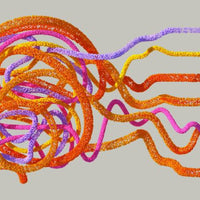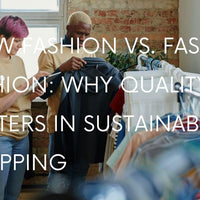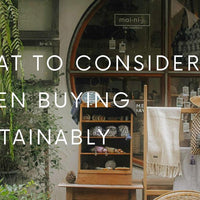This new, special material has just as special a story.
In the Northern Italian alps, sits a region named Bolzano where the renown production of apples creates a significant amount of waste. Alberto Volcan, an inventor from the region, was looking for ways to make use of the leftover apple cores and skins.
One of his first creations was a glue, which wasn’t very successful. So he reworked the glue and placed it through a pasta machine back in 2004. The sheet of fabric created became the very basis of apple leather!

Developed further and made commercially viable with the help of a company named Frumat, this ecological, breathable, waterproof and durable material has been a game changer in the industry.
When apples are used for manufactured foods like juice, cider or sauce, there are solids left over called apple pomace. Due to its high cellulose content, apple pomace is ideal for creating new fabrics. This has led to upcycled clothing & accessories we see with burgeoning sustainable clothing brands today.
The key, fashion-wise, is that cellulose based materials are incredibly versatile and can be easily personalized with a variety of textures, thicknesses, embossing or laser printing.
But it can’t be all apple, can it?
APPLE SKIN VEGAN APHRA SHOULDER BAG - BURGUNDY
CHLOË - APPLE LEATHER CROSSBODY BAG
While your vegan crossbody bag is not 100% apples, it is many steps in the right direction. One of the most impacting things about using apple pomace is that it’s an entirely renewable resource, reducing the CO2 impact significantly compared to faux leathers composed of 100% fossil fuels.
The most notable environmental impacts come from large reductions in ozone depletion, land use and marine ecosystem destruction. Most alternative leathers, however, have a small amount of PU based materials, whether it be corn leather, pineapple leather, mushroom or grape.
Gladly, plant-based polyurethanes are progressing towards more and more renewable states and as technology improves, our reliability on PU will be reduced significantly. We’re just not there yet.
In the meantime, this mixture of materials ensures the durability and longevity of your vegan shoes or your leather wallet while greatly reducing its carbon footprint.
Compared to animal-based leather, any vegan leather is at least ⅓ of the harm to the environment according to the Sustainable Apparel Coalition’s Higg Materials Sustainability Index. Plant-based leathers take this even further.
One argument that is commonly used in favor of animal-based leather is that it’s reusing waste material from another industry, the factory farming industry, but in order to have a meaningful impact we know we need to reduce animal farming altogether.
-
You may ask, but won’t cow hide dissolve into the earth? Unfortunately, 90% of the world’s fashion leather is chrome tanned and will not biodegrade at all. With more and more brands supporting the sustainable economy with vegan fabrics like apple leather, the price of vegan leather goods will be driven down and cause more ethical clothing brands in Australia and beyond to be able to emerge.
The more that come to fruition (pun intended), the better able we are to research and develop more renewable plant-based PU’s or alternatives and drive emission numbers into the ground. So in the meantime, viva la pasta and your scrumptious accessories.








0 comments